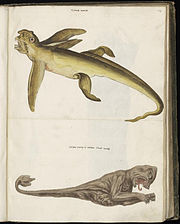Cryptids are animals that cryptozoologists believe may exist somewhere in the wild, but whose present existence is disputed or unsubstantiated by science. Cryptozoology is a pseudoscience, which primarily looks at anecdotal stories, and other claims rejected by the scientific community. While biologists regularly identify new species following established scientific methodology, cryptozoologists focus on entities mentioned in the folklore record and rumor. Entities that may be considered cryptids by cryptozoologists include Bigfoot, Yeti, the chupacabra, the Jersey Devil, the Loch Ness Monster, and the Mokele-mbembe.
Scholars have noted that the cryptozoology subculture rejected mainstream approaches from an early date, and that adherents often express hostility to mainstream science. Scholars have studied cryptozoologists and their influence (including its association with Young Earth creationism),[1][2] noted parallels in cryptozoology and other pseudosciences such as ghost hunting and ufology, and highlighted uncritical media propagation of cryptozoologist claims.
List
Aquatic or semi-aquatic
| Name | Other Names | Description | Purported Location | Depiction |
|---|---|---|---|---|
| Cadborosaurus[3] | Caddy | Sea animal | Pacific Coast of North America | 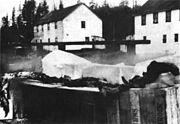 |
| Champ[4] | Champy | Lake monster | Lake Champlain, North America |  |
| Cryptid Whales[5][6] | Giglioli's Whale, Rhinoceros dolphin, High-finned sperm whale, Alula whale, Unidentified beaked whales | Sea animal | Pacific Ocean, Atlantic Ocean, Indian Ocean |  |
| Dobhar-chú[7] | Water Hound, King Otter | Extra-large otter-like carnivorous aquatic mammal | Ireland | 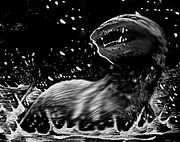 |
| Gloucester sea serpent[8] | Large serpent | Gloucester, Cape Ann | ||
| Iemisch[9] | Iemisch Listai | Mix of a jaguar and otter | Patagonia | |
| Igopogo[10] | Kempenfelt Kelly | Lake monster | Lake Simcoe, Ontario (Canada) | |
| Isshii[citation needed] | Issie | Lake monster | Japan | |
| Labynkyr Devil[11][12][13] | Labynkyrsky Chert[citation needed] | Lake monster | Oymyakonsky Ulus, Sakha Republic, Russia | |
| Loch Ness Monster[14] | Nessie | Lake monster | Loch Ness, Scotland |  |
| Loveland Frog[15] | Loveland frogman, Loveland lizard | Humanoid frog | Loveland, Ohio |  |
| Manipogo[16] | Winnipogo | Lake monster | Lake Manitoba, Canada | |
| Megalodon (surviving population)[17][18][19] | Otodus megalodon[lower-alpha 1] | Giant prehistoric shark | Oceans |  |
| Mokele-mbembe[20] | Dinosaur (lake, river and/or swamp monster) | Republic of the Congo | 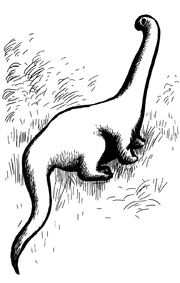 | |
| Ogopogo[4] | N'ha•a•itk, Naitaka | Lake monster | Lake Okanagan, Canada | 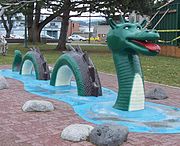 |
| Sea serpents[21] | Sea animals, dinosaurs | All bodies of water |  | |
| Selma[22] | Seljordsormen | Lake monster | Lake Seljord, Telemark, Norway | |
| Steller's sea ape[23] | Sea animal | Pacific Ocean |
Terrestrial
| Name | Other names | Description | Purported location | Depiction |
|---|---|---|---|---|
| British big cats[24] | Alien big cats (ABCs), phantom cats, mystery cats, English lions, Beast of Bodmin, Beast of Exmoor |
Carnivorous mammal | Great Britain |  |
| Capelobo[25] | Humanoid anteater monster | Brazil |  | |
| Chupacabra[26] | Chupacabras (Spanish for goat-sucker) | Puerto Rico (originally), South and Central America, Southern North America |
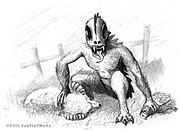 | |
| Dover Demon[27] | Dover, Massachusetts | |||
| Lizard Man of Scape Ore Swamp[28] | Lizard Man of Lee County | Bipedal | South Carolina, United States | |
| Mapinguari[29] | Mapinguary | Giant Ground Sloth or primate | Amazons |  |
| Michigan Dogman[30] | Humanoid dog | Wexford County, Michigan | ||
| Minhocão[citation needed] | Big Earthworm | Caecilian | South America | |
| Mongolian death worm[31] | Allghoi (or orghoi) khorkhoi | Worm-like animal | Gobi Desert (Asia) | 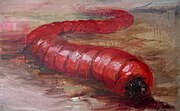 |
| Nandi bear[32] | Chemosit, Kerit, Koddoelo, Ngoelo, Ngoloko, Duba | Large carnivore | Eastern Africa | 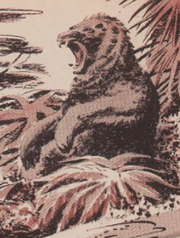 |
| Queensland Tiger[33] | Yarri | Large feline | Queensland | |
| Surviving/original Thylacine populations[34][lower-alpha 2] | Tasmanian tiger. Tasmanian wolf | Carnivorous marsupial | Australia |  |
Hominid
| Name | Other names | Description | Purported location | Depiction |
|---|---|---|---|---|
| Almas[4] | Abnauayu, almasty, albasty, bekk-bok, biabin-guli, golub-yavan, gul-biavan, auli-avan, kaptar, kra-dhun, ksy-giik, ksy-gyik, ochokochi, mirygdy, mulen, voita, wind-man, Zana |
Non-human ape or hominid | Asia/Caucasus | |
| Amomongo[35] | Orang Mawas, Impakta | Ape or hominid | Negros Occidental, Philippines | |
| Barmanou[citation needed] | Barmanu, Big Hairy One | Ape or hominid | Middle East/Asia | |
| Bigfoot[36] | Sasquatch | Large and hairy ape-like creature | United States and Canada |  |
| Bukit Timah Monkey Man[37] | BTM, BTMM | Forest-dwelling hominid or other primate | Singapore | |
| Chatawa Monster[38][39] | Large ape-like creature | Mississippi, United States | ||
| Chuchunya[40] | Large hominid | Russia | ||
| Fouke Monster[41][42] | Jonesville Monster, Southern Sasquatch, Boggy Creek Monster | Hominid or other primate | Arkansas, United States | |
| Honey Island Swamp monster[43] | Letiche, Tainted Keitre | Hominid or other primate | Louisiana, United States | |
| Orang Pendek | Small hominid | Sumatra |  | |
| Nittaewo[44] | Nittevo | Small hominids | Sri Lanka | |
| Skunk ape[45] | Stink Ape, Myakka Ape, Myakka Skunk Ape | Primate | Florida, United States |  |
| Yeren[46][45] | Yiren, Yeh Ren, Chinese Wildman | Primate (possible hominin) | China | |
| Yeti[47] | Abominable Snowman | Large and hairy human-like entity, various other descriptions | Himalayas (Asia) | 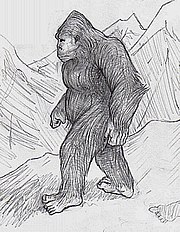 |
| Yowie[44] | Large and hairy human-like entity, various other descriptions | Australia | 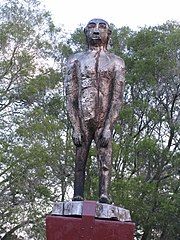 |
Flying
| Name | Other names | Description | Purported location | Depiction |
|---|---|---|---|---|
| Jersey Devil[14] | Leeds Devil | Winged bipedal horse | United States, mainly the South Jersey Pine Barrens, as well as other parts of New Jersey and southeastern Pennsylvania | 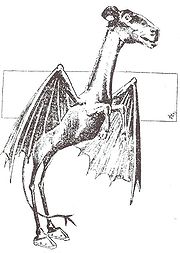 |
| Mothman[48] | Winged Man, Bird Man, UFO-Bird, Mason Bird Monster | Winged bipedal | Mason County, West Virginia, United States |  |
| Rod[49] | Skyfish, Air Rod, Solar Entity | Small flying stick-like creatures | Worldwide | 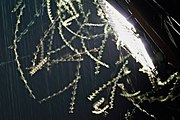 |
| Ropen[50] | Large bat-like creature or pterosaur | New Guinea |
See also
Notes
- Otodus is the currently accepted genus name for megalodon. Older sources refer to the genus as Carcharodon, Carcharocles, and several other names.
- There is an ongoing de-extinction project to revive the species through genome editing, this entry refers to the possibility of surviving populations.
References
Sources
External links
Wikiwand in your browser!
Seamless Wikipedia browsing. On steroids.
Every time you click a link to Wikipedia, Wiktionary or Wikiquote in your browser's search results, it will show the modern Wikiwand interface.
Wikiwand extension is a five stars, simple, with minimum permission required to keep your browsing private, safe and transparent.

